Building Capacity to Increase the Participation of People with Disabilities in Engineering (2015)
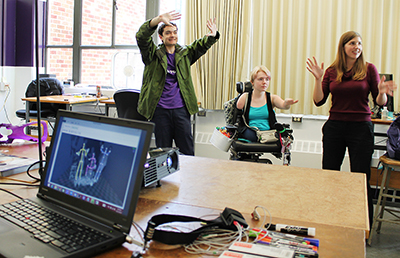
Proceedings of the April 2015 AccessEngineering Capacity Building Institute (CBI)
This publication shares the proceedings of a capacity building institute (CBI) entitled Building Capacity to Increase the Participation of People with Disabilities in Engineering. The content may be useful for people who
- participated in the CBI;
- seek to increase their understanding of issues surrounding the participation of students with disabilities in engineering studies and careers;
- are interested in integrating information related to disability, accessibility, and universal design into their engineering courses;
- would like to access resources to help make their courses, services, and activities more welcoming and accessible to students with disabilities; and
- have promising practices to share with others.
About AccessEngineering
AccessEngineering works to increase the participation of people with disabilities in education and careers in engineering and improve engineering fields with their perspectives and expertise. Central to this work is a faculty leadership team of sixteen faculty members at colleges and university across the country. AccessEngineering is led by the College of Engineering and the DO-IT (Disabilities, Opportunities, Internetworking, and Technology) Center at the University of Washington (UW) and is funded by the National Science Foundation (Grant #EEC-1444961).
AccessEngineering builds on theory and research to address immediate challenges facing engineering education today, including: increasing the size of the engineering workforce, diversifying engineering fields, and meeting institutional obligations under the Americans with Disabilities Act. The project focuses on two objectives:
- Better serving a diverse student body that includes students with disabilities in engineering courses and programs
- Integrating relevant disability-related and universal design content into engineering courses
The second objective is an opportunity to improve engineering education as a whole, which may lead to the development of more accessible technology by the next generation of professional engineers, while including information in the engineering curriculum that may be of particular interest to students with disabilities.
About the CBI
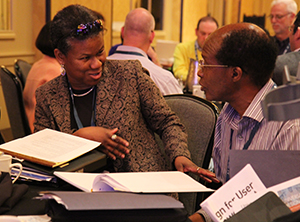
Building Capacity to Increase the Participation of People with Disabilities in Engineering, sponsored by AccessEngineering, was held in Seattle, WA on April 7–10, 2015. Its purpose was to encourage efforts to make engineering more welcoming and accessible to students with disabilities and enhance engineering curricula with disabilities-related topics. Attendees included engineering students and professionals with disabilities, postsecondary faculty and administrators, disability experts, and professional organization representatives.
As is typical of a CBI
- All participants contributed to its success.
- Speakers participated in group discussions.
- Experts in all topic areas were in the audience.
- Participants gave presentations and participated in large and small group discussions.
- Some predetermined professional development was presented, new content was delivered as the meeting unfolded, and participant interests were expressed and expertise was made known.
The CBI provided a forum for discussing recruitment and access challenges, sharing expertise and successful practices, developing collaborations, creating resources, and identifying systemic change initiatives relevant to the meeting’s goals.
Topics discussed include
- universal design of instruction and academic accommodations;
- the experiences of engineering students and professionals with disabilities;
- outreach activities designed to recruit students with disabilities into engineering;
- best practices for making courses welcoming and accessible to students with disabilities; and
- disability, accessibility, and universal design topics for engineering curricula.
The agenda for the CBI and summaries of the presentations, panels, and working group discussions are provided on the following pages.
CBI Agenda
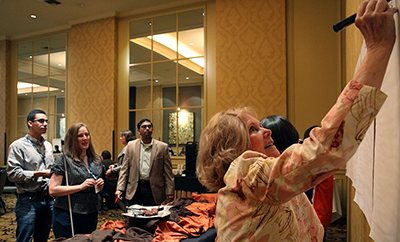
Tuesday, April 7
7 – 9 pm
Networking Reception
Wednesday, April 8
8 – 9 am
Breakfast and Networking
9 – 9:45 am
Welcome and Introductions
Sheryl Burgstahler, University of Washington
9:30 – 9:45 am
Video – STEM and People with Disabilities
9:45 – 10 am
Accessible Equipment
Lyla Crawford, University of Washington
10 – 11 am
Accommodations and Universal Design
Sheryl Burgstahler, University of Washington
11:15 am – 12:15 pm
Panel of Engineering Students and Professionals
Panelists: Kevin Cree, Nils Hakansson, Vincent Martin, Cindy Bennett
Moderator: Brianna Blaser, University of Washington
12:15 – 1:15 pm
Working Lunch
What could be done at an institution to promote greater participation and success of students with disabilities in engineering?
1:15 – 1:30 pm
Report Out
1:30 – 2:45 pm
Engineering Students with Disabilities
Invisible Challenges, Unmet Needs: Understanding Students with Psychiatric Disabilities
Mei-Fang Lan, University of Florida
Walking a Mile in Their Shoes: Experiencing What it is Like to Have a Learning Disability
Chang-Yu Wu, University of Florida
Strategies for Recruiting and Engaging REU Students with Disabilities
Chris Andersen and Michelle McCombs, Ohio State University
Ohio’s STEM Ability Alliance: Interventions and Outcomes for Students with Disabilities in STEM at Wright State University
Jason Gepperth, Wright State University
3 – 3:30 pm
Small Group Discussion
What are specific ways universal design and accessibility topics can be integrated into the engineering curriculum?
3:30 – 3:45 pm
Report Out
4 – 4:45 pm
Outreach and Students with Disabilities
Auburn University’s Promising Practices for K-12 Students with Disabilities
Overtoun Jenda, Auburn University
K-12 Engineering Outreach for Students with Disabilities: Inspiring Engineers Inside and Outside of the Classroom
Anna Leyf Starling, North Carolina State University
4:45 – 5:00 pm
Preview of Dinner Tonight and Tomorrow’s Topics
Complete Daily Feedback Form
6 – 8 pm
Dinner
What can be done to make engineering curricula more accessible to students with disabilities?
Thursday, April 9
8 – 9 am
Breakfast and Networking
9 – 9:15 am
Daily Overview
9:15 – 10:15 am
Presentation and Discussion: What can be done to make engineering labs, machine shops, and other activities accessible to students with disabilities?
Katherine Steele and Maya Cakmak, University of Washington
10:30 – 11 am
Disability, Accessibility, and Universal Design in the Engineering Curriculum
Gaming for the Greater Good: A Classroom Experience at the Intersection of Technology and Disability
David Chesney, University of Michigan
User-Centered Design and Accessibility in MIT 6.811: Principles and Practice of Assistive Technology
William Li, Massachusetts Institute of Technology
11 am – 12 pm
Resource Production
Individually or in groups, draft potential promising practices, Q&A’s, or case studies for our knowledge base or replication packages or provide input on draft publications.
12 – 1 pm
Lunch
How do we encourage others in our departments, institutions, professional organizations, and elsewhere to include information about disability, accessibility, and universal design in engineering courses?
1 – 1:30 pm
Report Out
1:30 – 2:30 pm
Film: Fixed: The Science/Fiction of Human Enhancement
2:30 – 3 pm
Discussion
How do the viewpoints of the individuals in the documentary Fixed affect how you would teach about topics related to disability and universal design in the engineering curriculum?
3 – 4:30 pm
Continue Development of Project Products
Complete Daily Feedback Form
Friday, April 10
8 – 9 am
Breakfast and Networking
9 – 9:15 am
Daily Overview
9:15 – 10:15 am
Disability, Accessibility, and Universal Design in the Engineering Curriculum (continued)
Strategies for Introducing Accessibility Topics into Engineering Courses
Richard Ladner, University of Washington
Senior Design Projects to Aid Individuals with Disabilities: The University of Toledo Experience
Mohamed Hefzy, University of Toledo
Using Design Projects to Serve Veterans with Disabilities
Samee Khan, North Dakota State University
Universal Design in a Web Design and Development Course Curriculum
Terrill Thompson, University of Washington
10:30 – 11:15 am
Working with Professional Organizations
Making Professional Organizations More Inclusive for People with Disabilities: A Case Study
Jonathan Lazar, Towson University
Advancing Access and Inclusion in the STEM Workforce through Professional Society Partnerships
Chris Atchison, University of Cincinnati
11:15 am – 12 pm
Continue Development of Project Products
12 – 12:15 pm
Wrap Up: Where Do We Go From Here?
Evaluation
12:15 – 1 pm
Lunch, Networking, and Discussion
How can we continue to work together to promote the participation of people with disabilities in engineering and the inclusion of information related to disability, accessibility, and universal design in the engineering curriculum?
Presentation Summaries
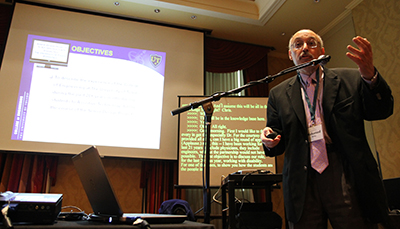
Accessible Equipment for Science and Engineering Labs
Specialized equipment makes science and engineering labs more accessible, including tools such as magnetic stirrers; talking scales, thermometers, and tape measures; large print labels; liquid level indicators; and nonslip mats. They showcase how labs can be made more accessible, especially when universal design principles are considered in designing the lab and procuring equipment.
When working with vendors, ask about accessibility and emphasize your preference to use accessible software and equipment and commitment to help your institution meet its requirements under the Americans with Disabilities Act. By providing accessible technology and equipment, vendors make their products more marketable to postsecondary institutions. Accessible equipment and tools contribute to increasing the participation of students with disabilities in science and engineering fields.
For examples of accessible science equipment and where it can be purchased, consult our DO-IT publication Accessible Science Equipment.
Accommodations and Universal Design
Ability exists on a continuum, where individuals are more or less able to see, hear, walk, read print, communicate verbally, tune out distractions, learn, and manage their health. For a long time, children with disabilities were kept out of mainstream education. Often, people with disabilities have been seen as people who needed to be cured or rehabilitated. However, after World War II and the Civil Rights movement, a social justice oriented approach to disability emerged, supporting the right for people with disabilities to have full access to K-12 and postsecondary education.
In the K-12 system, children with disabilities are offered free, appropriate education in as integrated of a setting as possible. However, in postsecondary education, students with disabilities must meet course or program requirements, with reasonable accommodations as requested. Accommodations include extra time on tests, a book in an alternate format, and a sign language interpreter. Whereas accommodations are a reactive process for providing access to a specific student and arise from a medical model of disability, universal design (UD) is a proactive process rooted in a social justice approach to disability. UD advocates value diversity, equity, and inclusion.
UD is the design of products and environments to be usable by all people, to the greatest extent possible, without the need for adaptation or specialized design. UD is beneficial to all students, not just students with disabilities; for example, people who face challenges related to socioeconomic status, race, culture, gender, age, and language also benefit from UD practices. Universally designed information technology has built in accessibility features and ensures compatibility with assistive technology. A universally designed website has text alternatives for graphics, content presented via text and visuals, captioned and transcribed video and audio content is captioned and transcribed, content and navigation that can be reached with the keyboard alone, spelled out acronyms. and other characteristics that benefit a diverse variety of visitors.
UD can be implemented incrementally, focuses on benefiting all students, promotes good teaching practice, does not lower academic standards, and minimizes the need for accommodations. UD can be applied to all aspects of instruction, including class climate, interactions, physical environments and products, delivery methods, information resources and technology, feedback, and assessment. Examples include
- Arranging seating so that everyone has a clear line of sight.
- Avoiding undue attention being drawn to differences between students.
- Using large, bold fonts with high contrast on uncluttered overhead displays and speaking all content aloud.
- Providing multiple ways to gain and demonstrate knowledge; using multiple senses.
- Avoiding unnecessary jargon; defining terms.
- Providing scaffolding tools (e.g., outlines).
- Providing materials in accessible formats.
- Providing corrective opportunities.
- Testing in same manner in which you teach.
- Minimizing time constraints as appropriate.
Educators who effectively apply UD and accommodations level the playing field for students with disabilities and make instruction welcoming to, accessible to, and usable by all students. DO-IT hosts a comprehensive resource, The Center for Universal Design in Education, which features guidance on how to apply UD to instruction, physical spaces, student services, and technology.
Engineering Students with Disabilities
Invisible Challenges, Unmet Needs: Understanding Students with Psychiatric Disabilities
By Mei-Fang Lan, University of Florida
Increasing number of students with mental health disabilities are enrolled in college. Without adequate support, young adults experiencing a mental health issue are more likely to receive lower GPAs, drop out of college, or be unemployed than their peers without a mental health challenge. Unfortunately, most college students with mental health problems do not receive treatment. In a recent study by Dr. Eisenberg and his colleagues, they found that, among students with apparent mental health problems, approximately one in three received mental health treatment in the previous year. Reasons for not seeking treatment include thinking that problems will get better by themselves, stress is normal in college, and there is no time to seek treatment.
In spite of these trends, postsecondary students with mental health issues often do not receive adequate treatment and support to succeed in college and graduate school. It can be difficult for students to explain how they are affected. This makes it especially important for postsecondary institutions to provide potential and enrolled students with mental health disabilities the resources and knowledge about potential accommodations that may help them succeed in school.
Walking a Mile in Their Shoes: Experiencing What it is Like to Have a Learning Disability
By Chang-Yu Wu, University of Florida
A learning disability (LD) is a neurological disorder resulting from a difference in the way a person’s brain is wired. Students with LDs have average or above intelligence but have difficulty with specific tasks such as reading, writing, spelling, reasoning, recalling, or organization. LDs cannot be cured. With the right support and intervention, people with LDs can succeed in school and go on to successful careers. The following are the most common LDs:
- dyslexia: difficulty reading
- dyscalculia: difficulty calculating mathematics
- dysgraphia: difficulty writing
Reasonable accommodations can help people with LDs succeed in college and careers. People with LDs often think outside of the box, seeing solutions to problems that someone else may not see. People with LDs bring different strengths to the table and diversity in solving problems, an asset in engineering fields. Successful people with learning disabilities include Albert Einstein, John Franklin Kennedy, and Alexander Graham Bell.
To glimpse into how people with different learning disabilities process the world, try out the exercises from PBS’s Misunderstood Minds.
For more resources on learning disabilities, visit
- University of Florida’s Comprehensive Support for Science, Technology, Engineering, and Mathematics (STEM) Students with Learning Disabilities
- The National Center for Learning Disability
- Understood for Learning and Attention Issues
- Learning Disabilities Association for America
- Learning Disabilities Online
Strategies for Recruiting and Engaging REU Students with Disabilities
By Chris Andersen and Michelle McCombs, The Ohio State University
Including students with disabilities in these research experiences brings more students into the engineering field and increases the diversity in ideas, perspectives, and solutions. The Center for Emergent Materials (CEM) at The Ohio State University recruits students with disabilities for engaging research experiences for undergraduates (REUs) through EntryPoint! and the Ohio STEM (science, technology, engineering, and mathematics) Ability Alliance (OSAA). In internships, students encounter experimental and theoretical research in physics and materials science. Part of their training is working with sophisticated lab equipment.
They provide training for faculty and mentors, ask faculty to commit to providing a supportive atmosphere for students, and seek out supportive graduate students to serve as mentors. They continue to provide support for both the faculty and the student in the lab, and, when necessary, they include the office of disability services in order to provide accommodations or address other needs. For students with visual impairments or physical disabilities, state vocational services or disability services provides support. Training for faculty members includes information about common issues, misconceptions, and resources. Follow up meetings with faculty are held after students have been in their labs for 2-4 weeks.
When faculty members are supportive and students are provided with the technology and workspace they need, students with disabilities succeed in engineering labs. It is important for students with disabilities to communicate their needs and utilize resources, including colleagues and disability services, to ensure they get support and accommodations. The students with disabilities who are interested in these research positions are equally qualified to any other student to complete the tasks and research required.
Ohio’s STEM Ability Alliance: Interventions and Outcomes for Students with Disabilities in STEM at Wright State University
By Jason Gepperth, Wright State University
Engineering is a growing major, and having more students with disabilities in engineering fields will provide more diversity and options. To address the underrepresentation of students with disabilities in engineering fields, Ohio’s STEM Ability Alliance (OSAA) was established in 2009 at Wright State University (WSU). WSU is a mid-sized research university with near open enrollment and a large population of non-traditional students. WSU’s nationally recognized Office of Disability Services (ODS) serves over 500 students annually.
OSAA’s main goals are to:
- Increase the recruitment of high school students with disabilities into STEM majors at WSU
- Increase retention and graduation rates for existing STEM students with disabilities
- Increase successful entry rates of OSAA STEM graduates with disabilities into STEM graduate programs or STEM employment
OSAA has two strategies for recruiting high school students. First, we host a 5-day residential summer camp called DiverseAbility U. for high school students with disabilities with a strong interest in STEM. Participants engage in STEM, personal skill development, and mentoring activities. Second, we reach out to incoming students through presentations at the ODS Orientation. These efforts have lead to a dramatic increase in the number of students with disabilities enrolling in STEM majors.
University students can also join the OSAA Scholars program and participate in learning communities, academic support through tutoring, and mentoring activities. OSAA helps connect students with internship and scholarship opportunities. Finally, OSAA offers Ability Advising, modeled on student athlete advising programs, through which an advisor acts as a mentor, coach, advocate, and facilitator to help a student address academic and personal issues.
OSAA Scholars have an 85% first year retention rate, compared to 61% for all students across campus. Likewise, 73% of the 2009 OSAA cohort graduated in 5 years, compared to the 40% WSU six year graduate rate. Along with National Science Foundation funding, WSU began providing internal financial support for OSAA in 2014.
Outreach and Students with Disabilities
Auburn University’s Promising Practices for K-12 Students with Disabilities
By Overtoun Jenda, Auburn University
The Office of Diversity and Multicultural Affairs at Auburn University engages in efforts that help students from a wide variety of underrepresented groups succeed in college and get into successful careers. We focus on increasing the number of students with disabilities pursuing science, technology, and engineering. Some capable students with disabilities are not encouraged to attend college while they are in high school; that is something we would like to change.
At Auburn, we host educational conferences and presentations that focus on how students with disabilities can successfully transition to college, including an annual statewide transition conference for high school special education students. Through these presentations, teachers, parents, and students learn more about accommodations, living arrangements, success stories, and a wide variety of other transitional topics.
Auburn also has multiple summer camps. Our Computer Science K-12 Inclusive Outreach camp aims to create an environment that is inclusive of students with disabilities in elementary and middle school; it introduces computer science and computational thinking. Our week-long ACT/College Prep for high school students with disabilities, funded by the Alabama Governor’s Office on Disability, introduces students to a college campus while providing ACT and college prep materials and presentations from individuals with disabilities.
Finally, through the Alabama Alliance for Students with Disabilities in STEM, a National Science Foundation funded program that includes four universities, a community college, and local school districts, students participate in peer mentoring. In audition, Auburn students and faculty visit high schools, and high school students and teachers visit the Auburn campus. These activities help high school and postsecondary students learn about and prepare for the next steps in progressing through undergraduate and graduate studies and entering STEM careers.
K-12 Engineering Outreach for Students with Disabilities: Inspiring Engineers Inside and Outside of the Classroom
By Anna Leyf Starling, North Carolina State University
The Engineering Place at North Carolina State University educates, both directly and indirectly, the citizens of North Carolina, particularly K-12 students, about the nature of engineering and the opportunities and careers in engineering fields. Its goals are accomplished through hands-on, inquiry- and problem- based programs and informational workshops and tools. Our vision is that every student, educator, and parent in North Carolina will know what engineering entails as well as the impact that engineering has on everyday life. K-12 students engage in engineering through hands-on programs and informational workshops. We work on curriculum development and host a series of different programs, including Family STEM night, Engineering on the Road, and summer engineering camps.
This year, we are building on research and promising practices to increase efforts in actively recruit students with disabilities, taking care to address issues since engineering topics appeal to a variety of learners and a variety of skill sets. We recently published an article titled “Improving science scores for students with learning disabilities through engineering problem solving activities” in the Journal of the American Academy of Special Education Professionals that looked at how hands-on versus explicit instruction in engineering projects affects science quiz scores for students with learning disabilities and attention deficit hyperactivity disorder (ADHD). We found that students with learning disabilities or ADHD benefit from a combination of hands-on learning and explicit instruction. Teachers should provide students with structure, guided notes, and repetition of material, as well as opportunities to engage in hands-on, problem solving activities that allow students to apply what they know.
Incorporating engineering in K-12 education will better prepare all students for engineering programs in college and give them the background to be successful in engineering careers. We want to give students with disabilities the tools and role models to succeed. This year, we plan on hosting a summer engineering experience for students with visual impairments, as well as a STEM Career showcase for students with disabilities.
Teach Engineering provides a plethora of educational tools and resources on engineering topics.
Disability, Accessibility, and Universal Design in the Engineering Curriculum
Gaming for the Greater Good: A Classroom Experience at the Intersection of Technology and Disability
By David Chesney, University of Michigan
In the electrical engineering and computer science department at the University of Michigan, I teach two courses that include accessibility topics. The first, Gaming for the Greater Good, an intro course focused on creating a game with accessibility features for a specific disability, is used as a recruitment tool for students interested in computer science. The second, a software engineering capstone class, focuses on children with disabilities in the community and how to create accessibility solutions using the latest and greatest technology.
In each class, we focus on specific accessibility issues, usually around one individual’s needs. We go through a set of steps to solve the problem: proposing and pitching a solution, describing the requirements and design, building the product, and testing and maintenance. One example of a project we have designed includes using facial movements to control a keyboard. A number of the projects developed in these courses have commercial potential. We are in the process of forming a non-profit organization to commercialize software products where 50% of the revenue will go toward purchasing assistive technology for children with disabilities.
In these sorts of courses, social context and individual focus matter. Working with an individual with a disability helps students to better understand the engineering problem that they are trying to solve. Not only do these classes result in products that people with disabilities can use, but students in the class bring an awareness of accessibility into their careers as engineers. For more information on Gaming for the Greater Good, visit our website or watch a video about working with a child named Grace.
User-Centered Design and Accessibility in MIT 6.811: Principles and Practice of Assistive Technology
By William Li, Massachusetts Institute of Technology
At the Massachusetts Institute of Technology (MIT), we have a full semester, project-based course called Principles and Practice of Assistive Technology (PPAT). In the course, engineering students develop customized, assistive devices with people with disabilities in the Boston area. Students enroll in the class because of its project-based design, the survey learning opportunity, or a personal interest or experience with disability. In 2014, 35 students enrolled in the class and worked with 11 clients.
PPAT Learning goals include
- Demonstrating the principles of user-centered assistive technology design and engineering.
- Learning how to work with a real client in a design/engineering team project.
- Understanding the challenges and realities of people with disabilities and becoming equipped as an advocate.
Students work on their projects each week, which includes client meetings, iterative design and evaluation, and prototyping and fabrication. Two hours per week are dedicated to lectures where students learn about communicating with people with disabilities, user-centered design, clinical perspectives, and more. Another two hours per week are spent on lab activities, surveying campus facilities for accessibility, and creating short films.
Examples projects are
- The Claw, a tool to help individuals grip objects better;
- Successible Maps, a tool that showed all the accessibility features on campus; and
- Your Friendly Reminder, an application that sends reminders out for the day.
In Feburary 2015, we hosted our first hackathon, a large event centered around students creating assistive technology in one day. Eighty students and 17 clients participated. The event was organized by undergraduates and many students who had taken PPAT participated.
To learn about student projects and the design process, visit the student-run design blog.
Strategies for Introducing Accessibility Topics into Engineering Courses
By Richard Ladner, University of Washington
Having an entire class on accessibility in web design or engineering is great; however, it’s possible to incorporate accessibility topics into almost any engineering class. You could give part of a lecture, a full lecture, or an entire course on an accessibility topic. Teaching about accessibility or inviting in a guest speaker can help change engineering knowledge and perspective as a whole.
There are interesting engineering problems that have to do with accessibility. These are good ways to include information about them as part of a lecture. For example, when discussing data compression, you could use an example about braille. Signal processing lectures could draw from acoustic modems used in TTY systems or directional hearing aids. Other courses lend themselves to having a whole lecture on accessibility topics. A human computer interaction course might include lectures on universal design or ability-based design. A computer vision course might include a lecture on tactile graphics.
Beyond including accessibility in mainstream courses, consider offering an entire course in your department. This could be as part of a freshman design course, like ones that exist at the University of Michigan or the University of Portland or a capstone course, like at MIT, the University of Michigan, or at the University of Washington (UW). When talking about accessibility topics, any course can introduce profiles of successful scientists and engineers who happen to have a disability.
If disability topics are included multiple times throughout the curriculum, students realize that these are important issues. It’s great to weave accessible design knowledge throughout a student’s education. Having a whole course, as well as individual lectures within courses, promotes the idea that these issues are common in engineering and computing.
Senior Design Projects to Aid Individuals with Disabilities: The University of Toledo Experience
By Mohamed Hefzy, University of Toledo
For the past twenty years at the University of Toledo, we have been introducing students to assistive technology through senior design projects. There are over 35 million people in the United States who have disabilities, all of whom have different needs. A lot of the assistive technology needed is either unavailable, very expensive, or requires custom modification. Many people with disabilities cannot afford custom modifications.
In 1988, the National Science Foundation began a program called Bioengineering and Research to Aid the Disabled (BRAD), which provides funding for engineering students to construct custom designed devices and software for individuals with disabilities. These projects provide unique opportunities for students, improve the quality of life for people with disabilities, and allow universities to provide a service to their communities.
Since 1994, at the University of Toledo over 600 students have participated in over 150 projects. Through the class, approximately 100 students per year participate in self-directed, semester-long group projects for both commercial and private clients. We start identifying project ideas before the semester begins through our partnerships with community organizations. Students rank the projects that they are interested in and are assigned to groups. Within groups, each student is assigned a role and submits weekly progress reports throughout the semester. During the eighth week of the semester students present their preliminary designs, and by the tenth week they begin constructing and testing a prototype.
The teams showcase their projects at the Undergraduate Research and Senior Design Engineering Project Exposition. In a recent project, students designed a temporary prosthetic for a nun who had lost all of her limbs following an infection. Their design placed first in the 2014 Rehabilitation Engineering and Assistive Technology Society of North America (RESNA) Student Design Competition.
We see multiple benefits from this course, including
- Students gain new experiences and perspectives,
- Clients have improved quality of life, and
- The university gains connections to our community.
Using Design Projects to Serve Veterans with Disabilities
By Samee Khan, North Dakota State University
In our courses at North Dakota State University, engineering students develop customized assistive technologies for veterans with disabilities. Student projects must be cost-effective, have a long lifespan, be robust, and be technologically superior to existing options.
Students enroll in a three semester sequence of courses. The first semester focuses on the ideology of building accessible designs. The second semester we focus on the project itself, including design stages, creating a plan for the client, and ordering parts. The third semester focuses on further development, prototyping, feasibility, testing with the client, and long term plans.
Often after the course is finished, students continue to work on the technology that they have developed. There have been seven patents awarded to technology developed through these projects, and two start-up companies have formed, Myriad Devices and Packet Digital. Project examples include a device that turns sign language into text, a voice-controlled door opener, and a voice-activated vending machine. Find more information about the courses and student projects online.
Universal Design in a Web Design and Development Course Curriculum
By Terrill Thompson, University of Washington
When creating digital content such as web pages or online documents, we may envision our typical user as an able-bodied person using a desktop computer. In reality, users utilize a wide variety of technologies to access the web including assistive technologies and mobile, and everyone has different levels of ability when it comes to seeing, hearing, or using a mouse or keyboard.
Diversity among web users provides technology teachers with a great opportunity. When learning to code, students should actively consider their users, including user differences. In partnership with K-12 teachers in the Bellingham, WA school district, DO-IT developed a web design curriculum. It is platform and vendor-neutral, so that it teaches concepts rather than how to use a specific tool. Standards-based, accessible design is taught early as a core design principle, and reinforced throughout the course.
For assignments students must use valid code and conform to accessibility standards. For example, when learning how to add an image, students are taught to use alt tags. Likewise, they are taught to add caption files to videos. The curriculum is constantly being upgraded, is freely available, and has been used across the US and the world.
To access the web design and course curriculum for your own use, visit DO-IT's website. For more information about web accessibility, check out these resources:
Working with Professional Organizations
Making Professional Organizations More Inclusive for People with Disabilities: A Case Study
By Jonathan Lazar, Towson University
It’s important to make courses accessible to people with disabilities, but we also need to consider future employment. Professional organizations and conferences play a major part in career development, including
- Career development through conference attendance and presentation
- Consumption and production of digital resources including blogs, websites, and digital libraries
- Mentorship programs, networking, and job searches
- Informal socializing among peers
We need to make sure all of these things, and the professional organizations running them, are inclusive of people with disabilities. There are three potential areas to focus on:
- physical conference accessibility including accessible conference facilities, accessible hotel rooms, and sign language interpretation
- digital resource accessibility including the paper submission and reviewing
- professional organization accessibility including mentorship programs and officer elections
The Association for Computing Machinery’s (ACM) Special Interest Group on Computer-Human Interaction (SIGCHI) has been working to improve accessibility. Discussion on the topic began in January 2011 during a long-term planning meeting for the SIGCHI organization. Tasks were divided into two areas: physical accessibility and digital accessibility, since different people in different roles usually have responsibility for each
Physical accessibility included designing a checklist for conference accessibility, site walkthroughs of potential conference sites, adding someone as the physical accessibility chair to the conference committee, and posting information on the website about the physical accessibility of conference locations and hotels.
Planning for digital accessibility has been more complicated. We had professional evaluations done to ensure accessibility of our conference web site and mobile app. We have also worked on publication to ensure the submission and review processes as well as accepted papers are accessible. Ultimately, we designed five specific guidelines for pdf accessibility. Easy to understand guidelines were developed and posted on the website. An automated check based on these guidelines was run on accepted papers and results were sent to authors. Making the pdf accessible was encouraged, but not required.
If you’d like to make your professional organization more accessible, consider the following:
- Reach out to the ACM Special Interest Group on Accessibility (SIGACCESS) and AccessComputing.
- Add feedback loops, in both directions.
- Include people with disabilities in your decision-making processes
- Be clear about prioritization and communicate the rationale.
- Recognize and explicitly address and communicate trade-offs.
Advancing Access and Inclusion in the STEM Workforce through Professional Society Partnerships
By Chris Atchison, University of Cincinnati
According to the United States Office of Personnel Management, “A key goal of federal government recruitment policies is to attain a workforce that draws from all segments of society and that leverages diversity to deliver the best public service.” However, STEM disciplines are still lacking diversity, particularly when it comes to individuals with disabilities. Opportunities for STEM careers are growing; these are careers where individuals can earn good salaries.
Students with disabilities are often discouraged from pursuing geoscience disciplines because of the significant requirement of field-based study. The image of a geoscientist evokes field research in remote and rugged areas, which are often not accessible for students with mobility or sensory impairments. The reality is that there are geoscientists with disabilities and ways to ensure that students with disabilities can participate in fieldwork.
Through promoting a broad and inclusive pathway, we can help to increase the participation of students with disabilities. This could include programs that foster interest among elementary school students, outreach activities aligned with career and educational opportunities for middle school and high school students, and financial assistance to support postsecondary education.
I have been working to create change through my organization, the International Association for Geoscience Diversity (IAGD). The IAGD mission is to improve access to the geosciences for individuals with disabilities while promoting communities of research, instruction and student support. The IAGD community
- Celebrates the diverse abilities of all geoscientists while fostering student engagement in geoscience career pathways.
- Provides faculty professional development in instructional access and inclusion.
- Unifies and promote efforts of collaboration in research and instructional best practices.
- Develops a community of resources for faculty and student support.
- Advances knowledge of access and accommodation within the geosciences through scientific research.
Panel Presentation Summary: Panel of Engineering Students
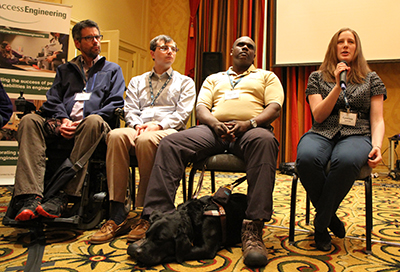
Panelists: Kevin Cree, Nils Hakansson, Vincent Martin, Cindy Bennett
Moderator: Brianna Blaser, University of Washington
Panelists answered questions about their experiences pursuing postsecondary education as students with disabilities. Below is a summary of their answers to each question.
What are some challenges you have faced in school or the workplace?
- Educators and supervisors create a challenge when they do not give a high priority to accessible materials and software. I have had to come up with a number of creative solutions to gain access.
- Inaccessibility can be an issue with group work. Google Docs was inaccessible for a long time. This put me in the place of telling my group that we couldn’t use a tool that other group members liked.
- I often had to pay out of pocket for software, computers, or equipment to make something accessible for me.
- My instructors have had difficulty understanding my written work because my learning disability affects my writing. Rather than communicating with me about solving the problem, some teachers have been disrespectful. Completing work electronically is one solution to this problem.
- Testing for learning disabilities is expensive and time consuming; however, students are required to have these sorts of tests done to qualify for the accommodations they need to be successful.
- As a faculty member, my lab floor was not very accessible for my wheelchair, so we had to build a new floor.
- On campus, a lot of the infrastructure is older and built without accessibility in mind. It was a long process to get handles installed on doors that had doorknobs so that I could open them. I have been working on campus with the team that designs new buildings to try and make sure new construction is accessible from the start.
- The main bathroom I used on campus was technically ADA compliant, but didn’t have room for side transfer from my wheelchair. Issues like that show why people with disabilities need to be included in the conversation from the start, and bathrooms and other rooms need to be made with a wide variety of needs in mind.
What has kept you motivated to continue working through accessibility barriers?
- My mother has always been a big motivation—when I first participated in the Paralympics and when I graduated from college, my mother always reminded me of my accomplishments and how proud I made my family.
- I never want to be in poverty or dependent on others. Money is a strong motivation.
- Seeing other students with disabilities graduating school and getting great careers really paved the way for me and showed me I could do it. I hope my success can help pave the way for someone else.
- I want to show people that I can do it, regardless of my disability. I tell employers that I am dyslexic, and show them the tools I use so that they know my disability will not be a barrier.
- I love what I do and really enjoy it—every day is an opportunity to grow and see that “aha moment” in others.
What has been your best strategy to get what you need to succeed?
- Working with the office of accessibility on campus and getting someone to support both me and my instructors.
- Talking personally with professors and working out solutions together.
- Following others who have had similar disabilities—I am very fortunate to have a number of allies and role models. The more people communicate and work together the more accessible things will become.
- Using the law to make sure my education, transportation, and work are accessible.
- Working with others with disabilities—although this isn’t always easy, since we have to find each other.
- Creating a network of mentors who offer me support.
- Finding a safe environment to be open about my disability and accessibility issues.
What recommendations do you have for employers?
- A job interview is not the best chance to learn about how a person with a disability uses technology. If employers know more about assistive technology and accessibility, it wouldn’t have to be brought up at every interview.
- Employers should know that people with disabilities work just as hard or even harder than people without disabilities. People with disabilities constantly have to solve problems and have a strong skillset in taking steps to find solutions.
- I will work just as hard or even harder than a person without a disability because I’m used to having to solve my own access challenges on a daily basis.
- Keep the lines of communication open about disability. Employers should be open to talking about accommodations and finding answers.
- Make sure you have accessible infrastructure, so people can access your buildings and environments.
- Be explicit about what you are looking for and any accessibility issues. If you don’t have an accessible environment, then certain people with disabilities may be miserable there.
What should people without disabilities do to improve accessibility?
- Design with accessibility in mind and speak up about considering all levels of ability in design projects.
- Think in terms of how you would access something in a variety of situations; put yourself into the shoes of others with a wide variety of disabilities.
- Admit what you don’t know and ask questions to find solutions, but be aware of not calling people out or asking inappropriate questions.
- Get to know a person beyond their disability.
- Teach more about universal design in school.
What could be done to promote the participation and success of students with disabilities in engineering?
- Make sure funding for assistive technology, accessibility, and accessibility training needs are in the annual budget.
- Provide more training about working with students and employees with disabilities.
- Give students options of different types of assessments.
- Teach faculty how to make small changes so that their teaching will be more accessible without overhauling the entire curriculum.
- Provide a comprehensive support system to ensure students with disabilities have the accommodations they need and access to mentoring.
- Include disability in diversity discussions to promote positive change.
- Promote relationships between faculty members, disability services, staff, and students to have open discussions about students’ needs and expectations.
- Ensure your website is accessible.
- Raise awareness across campus and include accessibility issues in on-campus peer groups.
- Make labs more inviting and accessible.
- Expose students with disabilities to successful role models in engineering fields who happen to have disabilities.
Working Group Discussion Summaries
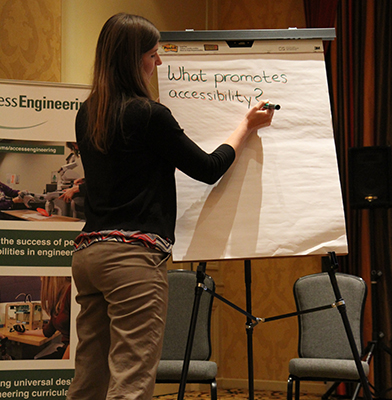
What can be done to make engineering labs, machine shops, and other activities accessible to students with disabilities?
By Katherine Steele and Maya Cakmak, University of Washington
This session included a presentation followed by a discussion.
What are the big things that we need to consider while making engineering labs, machine shops, and other activities as accessible as possible? We have been developing guidelines to help make hands-on learning more accessible in engineering labs and machine shops. This work draws from DO-IT’s publication Making Science Labs Accessible to Students with Disabilities and site visits to UW’s machine shop and engineering labs.
Using the Beam Robot, CBI participants took a virtual tour of the hardware lab in UW’s Computer Science and Engineering Department.
Elements of UD incorporated into the lab space included
- All cords run through the ceiling, and therefore aren’t a tripping hazard.
- All workstations have the same tools and feel, so no one feels isolated and everyone can be comfortable at any space.
- Buttons have tactile differences, so someone could use them by feel.
Elements that might present challenges for students with disabilities include
- Equipment that is on high workbenches that some individuals may be unable to reach
- Fluorescent lighting throughout the lab
- Workbenches that are not height adjustable
- Narrow aisles
- Analog dials on equipment may not be very accessible
- Uncertainty about how students with disabilities can contribute to group work
Strategies for increasing accessibility of engineering labs and machine shops include
- Different textures to label areas on items
- Plastic instead of glass
- Preferential seating
- Enlarged screens or microscopes
- Adjustable-height work surface
- Provide written and verbal instructions
- Modified procedures to use larger weights, computer numerical control (CNC), LabView, virtual instruments, or 3-D printing when a project as assigned is inaccessible
- Explicit strategies for ensuring that students with disabilities are playing an active role in group work, participating in hands-on work, leadership, or note taking
Some other resources that address accessibility issues in labs and machine shops include
- University of Pittsburgh’s Human Engineering Research Laboratory’s accessible machine shop and prototyping facility allows engineers with disabilities to use accessible equipment.
- Purdue University’s Accessible Biomedical Immersion Laboratory provides the opportunity to do biomedical research in an accessible and inclusive environment.
- Independence Science showcases fully accessible science classrooms and the integration of students with disabilities.
- Seattle Lighthouse for the Blind has been training people with visual impairments to become Boeing machinists.
What could be done at an institution to promote greater participation and success of students with disabilities in engineering?
CBI participants made the following suggestions:
- Increase accessibility awareness among faculty. Share best practices and case studies with them.
- Create a better support system for staff, faculty, and administration.
- Market engineering fields to students with disabilities, showcasing how engineering can benefit people with disabilities and the wide range of research that can be done in the field.
- Provide engineering-focused outreach events to middle and high school students with disabilities, including summer camps, workshops, and early entry classes.
- Partner with organizations on your campus or in your community that support individuals with disabilities.
- Teach courses on assistive technology to raise awareness about accessibility and universal design.
- Actively invite people with disabilities to meetings about diversity and other large impact conversations; include disability in diversity expectations.
- Focus on the individual strengths of each person.
- Start campus campaigns with staff, students, and faculty involved to raise awareness about accessibility.
- Provide universally designed lab equipment to all students.
- Include disability content in national conferences focused on celebrating and advocating for diversity.
- Create better, more accessible infrastructure so that buildings are welcoming to all students.
- Provide transcription services, and train faculty on how to use them.
- Leverage state resources to provide more funding for accessibility.
- Provide more mentors for students with disabilities from both within the university and outside of it.
- Include the perspective of individuals with disabilities in design and implementation.
- Engage with other universities and colleges to both keep up with new universal design ideas, as well as to spread awareness.
- Ensure that students with disabilities get more hands-on experience with research.
- Organize a student group to meet with the Dean of Student Affairs and other important stakeholders on campus.
- Add information about universal design, accessibility, and disability into the curriculum. Integrate it into core courses and offer more in depth stand alone courses.
- Educate professional and social networks about the strengths, and opportunities to support students with disabilities.
What are specific ways universal design and accessibility topics be integrated into the engineering curriculum?
CBI participants made the following suggestions:
- Have presentations by students with visible and invisible disabilities to put a face on diversity.
- Include universal design in introductory classes and capstone projects so that all students consider it at least once during their education.
- Make accessibility just another principle of engineering and include it as a part of the standards to get ABET certified.
- Have more faculty and educators invested in accessibility to spread awareness in their classes and on campus.
- Work ADA and universal design into engineering policy classes.
- Raise awareness about universal design by including students with disabilities in engineering courses; have panels featuring students with disabilities so that engineering students can put a face to universal design and accessibility.
- Discuss different learning styles and abilities in engineering classes.
- Have a class that goes out into the community and does a design review, seeing how design affects real world people, including people with disabilities.
- Integrate universal design into how you teach your class. Use a variety of teaching and testing techniques and include multiple means for accessing information. Have adjustable tables and lab infrastructure, as well as computer programs (e.g., LabVIEW) and equipment.
- Be willing to modify labs or equipment for a variety of disabilities.
- Use web resources to educate faculty on what other campuses are doing with accessibility and universal design. Seek knowledge from experts in the field of universal design (e.g., DO-IT) to make sure all information is up to date.
- Encourage every project to have universal design included as a key element.
- Build in funding for making labs and classes accessible.
- Use case studies to show students what kinds of projects they can incorporate into their education and careers. Have students do a research project based around how engineering design or technology affects people with disabilities.
- Have multiple representations in class of people with disabilities, such as images and graphics in class and around campus.
- Have mandatory accessibility training for all educators.
- Get user feedback from the engineering community, including students with disabilities.
- Include employers and the industry in the conversation.
- Include universal design in every engineering class, just as part of the process like any other engineering principle. All students should think about cost-effectiveness, practicality, user-design and accessibility.
How do the viewpoints of the individuals in the documentary Fixed affect how you would teach about topics related to disability and universal design in the engineering curriculum?
CBI participants made the following suggestions:
- I should show the film in class or include a link to the film in the syllabus so students get a background in disability and universal design related to engineering.
- We should include more philosophy and ethics discussions and lessons in engineering curriculum.
- After showing the film, I would host a panel of students with disabilities to discuss their own experiences.
- They should make an abridged version of the film as a stepping off point to discuss disability in engineering.
- Other films and lessons to include in engineering curriculum are Part of Me, Not All of Me or the Ted Talk on Hugh Herr called “The new bionics that let us run, climb and dance."
- We should promote the idea of technology as a means for greater universal design and promoting diversity. Technology and adaptation are about variety of the human experience, not just fixing a problem.
- I would screen this in some of my introductory classes and my capstone class, to show students that engineering is about diversity. I would also promote the idea of airing it during our campus diversity awareness week.
- If we promote the idea of design as a means of making anything possible, instead of “normalizing,” then we will create far more creative inventions.
How do we encourage others in our departments, institutions, professional organizations, and elsewhere to include information about disability, accessibility, and universal design in engineering courses?
CBI participants made the following suggestions:
- Add information, resources, and inclusive photos to our catalogs and websites.
- Require instructors to add universal design and accessibility information to their syllabi.
- Include universal design and accessibility to degree diversity requirements.
- Work with disability services offices to recruit students with disabilities and train faculty about accommodations.
- Promote more group work and projects instead of just lecture.
- Petition the Accreditation Board for Engineering and Technology, Inc (ABET) to add universal design to their criterion.
- Allow a variety of ways to measure student learning instead of just testing.
- Have more meetings around universal design and accessibility and celebrate all wins.
- Be proactive to making these changes instead of reactive.
CBI Participants
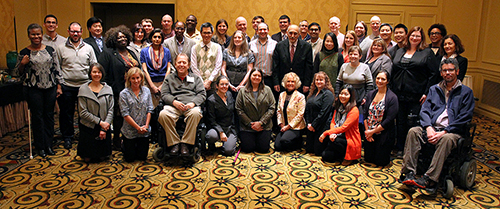
Stakeholder groups represented in the CBI included
- student service leaders and administrators,
- faculty members,
- students, and
- professional organizations.
The following individuals participated in the CBI.
Andersen, Christopher
Director, STEM Initiatives
Ohio State University
Atchison, Christopher
Assistant Professor
University of Cincinnati
Bennett, Cynthia
Ph.D. Student
University of Washington
Bhatti, Pamela
Associate Professor
Georgia Institute of Technology/Emory School of Medicine
Blaser, Brianna
Program Coordinator/Counselor
University of Washington
Burgstahler, Sheryl
Director, Accessible Technology Services
University of Washington
Cakmak, Maya
Assistant Professor, Computer Science and Engineering
University of Washington
Callahan, Bree
Director
University of Washington
Caspi, Anat
Director, Taskar Center for Accessible Technology
University of Washington
Chesney, David
Faculty
University of Michigan
Choi, Song
Assistant Dean
University of Hawaii at Manoa
Crawford, Lyla
Program Coordinator
University of Washington
Cree, Kevin
Student
Auburn University
Fahey, Katherine
Director, Student Disability Services
Cornell University
Garcia, Sergio
Graduate Research Assistant
Georgia Institute of Technology
Gepperth, Jason
Disability and STEM Resource Specialist
Wright State University
Gray, Kathryn
President, GrayTech Software, Inc.
University of Illinois, Urbana-Champaign engineering alumni
Hakansson, Nils
Assistant Professor
Wichita State University
Hefzy, Mohamed
Professor and Associate Dean of Graduate Studies of the College of Engineering
University of Toledo
Jenda, Overtoun
Associate Provost
Auburn University
Jones Calloway, Marcia
Director, Diversity & Inclusion
American Institute of Architects
Khan, Samee
Associate Professor
North Dakota State University
Ladner, Richard
Professor, Computer Science and Engineering
University of Washington
Lan, Mei-Fang
Clinical Assistant Professor
University of Florida
Lazar, Jonathan
Professor, Computer and Information Sciences
Towson University
Lee, Frank
Faculty
Bellevue College
Li, William
PhD Student / Graduate Instructor
MIT
Martin, Vincent
Graduate Research Assistant/ PhD student
Georgia Tech
McCombs, Michelle
Program Manager
Ohio State University
Mili, Fatma
Professor, Lead Purdue Polytechnic Institute
Purdue University
Moats, Steven
Director-Student Disability Resources
Iowa State University
Mortz, Margaret
Lecturer
Eastern Washington University
Park, Hae Won
Postdoctoral Fellow
Georgia Institute of Technology
Peixoto, Nathalia
Associate Professor
George Mason University
Sieglock, Joetta
Adaptive Technology Specialist
Eastern Washington University
Starling, Anna Leyf
Program Coordinator of The Engineering Place
North Carolina State University
Steele, Katherine
Assistant Professor, Mechanical Engineering
University of Washington
Stewart, Daniel
Graduate Research Assistant
University of Florida
Sundararajan, Sriram
Professor and Equity Advisor, College of Engineering
Iowa State University
Thompson, Constance
Senior Manager, Diversity & Inclusion
The American Society of Civil Engineers (ASCE)
Thompson, Terrill
Technoogy Accessibility Specialist
University of Washington
Tyson, Synge
Usability & Accessibility Consultant
Villalobos, Ric
Faculty Counselor
Spokane Community College
Wu, Chang-Yu
Professor and Department Head
University of Florida
Yasuhara, Ken
Research Scientist
University of Washington
Communities of Practice
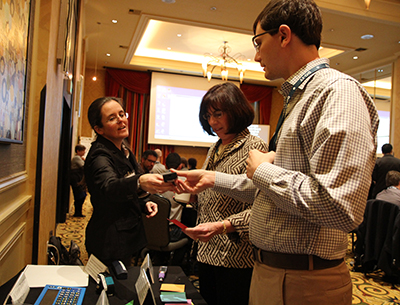
AccessEngineering staff and faculty leaders engage in an online Community of Practice (CoP) that includes key stakeholder groups that impact the success of students with disabilities in engineering programs (e.g., faculty, disability service units, online learning programs, veterans associations, career services, teaching and learning centers, diversity programs, professional organizations, employers) to share ideas and assist in the creation and dissemination of resources to encourage others to help a broader range of students pursue engineering fields and support them in their careers.
CoP members
- Share strategies for recruiting engineering faculty and administrators to participate in project activities.
- Share successful practices for recruiting students with a broad range of disabilities into engineering programs.
- Discuss how to engage, accommodate, and retain students with a wide range of disabilities in postsecondary engineering studies.
- Share disability-related and universal/accessible design content to be incorporated into senior design and other specific engineering courses.
- Learn about training videos, resources, and publications.
- Identify unmet needs and useful products for the project to develop.
- Provide input for a project video and related online resources.
- Respond to formative results of the project and suggest future activities.
- Share accessibility issues in their engineering courses and departments and brainstorm strategies for improvement.
- Explore strategies for adapting lab-based courses for universal/accessible design.
- Share forums for connecting students to engineers with disabilities in the local community and online.
- Discuss how robotic simulations and other technology can be used to improve access to hands-on educational activities for individuals with disabilities.
- Collaborate in the development of universal/accessible design topics in conference presentations and seminar series.
Join AccessEngineering CoP by sending the following information to DO-IT:
- Name
- Position/ Job Title
- Institution
- Postal Address
- Email Address
Resources
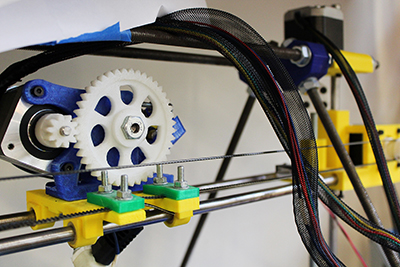
The AccessEngineering website contains
- information about project goals, objectives, activities, and project partners
- evidence-based practices that support project goals and objectives
- resources for students with disabilities
- educational materials for teachers and administration
AccessEngineering maintains a searchable database of frequently asked questions, case studies, and promising practices related to how educators can fully include students with disabilities in computing activities. The Knowledge Base can be accessed by following the “Search Knowledge Base” link on the AccessEngineering website.
The Knowledge Base is an excellent resource for ideas that can be implemented in engineering programs in order to better serve students with disabilities. In particular, the promising practices articles serve to spread the word about practices that show evidence of increasing the participation and success of people with disabilities in engineering.
Examples of Knowledge Base case studies, promising practices, and questions include
- Conference Engagement via Robot: A Case Study in an Option for a Student Unable to Travel
- Distance Learning: A Case Study on the Accessibility of an Online Course
- Emerging Leaders Program: A Promising Practice in Placing College Students with Disabilities in Challenging Internships
- Hosting a Panel of Students with Disabilities: A Promising Practice in Raising Awareness of Disability Issues
- Are electronic whiteboards accessible to people with disabilities?
- Are there scientific and graphing calculators that can be used by students who are blind?
Individuals and organizations are encouraged to propose questions and answers, case studies, and promising practices. Contributions and suggestions can be sent to DO-IT.
For more information on AccessEngineering, universal design, and accessible STEM education, review the following websites and brochures.
- To find more information on universal design, visit the Center for Universal Design.
- To learn more about and get involved with AccessEngineering, visit their website.
- For resources specifically designed for faculty, consult The Faculty Room.
Acknowledgments
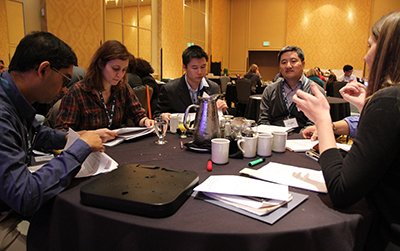
AccessEngineering capacity building activities are funded by the National Science Foundation (EEC-1444961). Any opinions, findings, and conclusions or recommendations expressed in this material are those of the CBI presenters and project staff and do not necessarily reflect the views of the National Science Foundation.
DO-IT
University of Washington
Box 354842
Seattle, WA 98195-4842
doit@uw.edu
www.washington.edu/doit/
206-685-DOIT (3648) (voice/TTY)
888-972-DOIT (3648) (toll free voice/TTY)
206-221-4171 (FAX)
509-328-9331 (voice/TTY) Spokane
AccessEngineering Principal Investigators:
Sheryl Burgstahler, PI
Maya Cakmak, Co-PI
Katherine Steele, Co-PI
Brianna Blaser, Project Coordinator
© 2015 University of Washington. Permission is granted to copy this publication for educational, noncommercial purposes, provided the source is acknowledged.